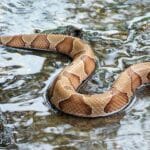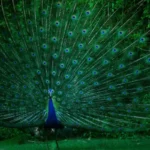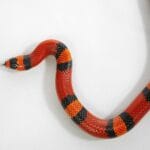Imagine yourself stepping onto a sun-dappled trail, the air alive with the sounds of birdsong. As you walk, a flicker of movement catches your eye – a snake basking in a sunny patch. Your heart might skip a beat, especially if you live in an area where both harmless rat snakes and venomous copperheads reside. But don’t panic! Knowing how to tell these two snakes apart can transform a moment of fear into a fascinating wildlife encounter and, most importantly, keep you safe.
Spotting the Difference: A Quick Guide
When it comes to snakes, a quick glance can often be misleading. Both rat snakes and copperheads can sport shades of brown and tan. Look closer, and you’ll notice some key distinctions:
- Head Shape: A copperhead’s most telling feature? Its triangular head, a sure sign it’s packing venom glands. A rat snake’s head, on the other hand, has a much smoother, oval shape.
- Eyes: Copperheads, like many venomous snakes, possess elliptical pupils, often described as “cat-eyes.” Rat snakes, on the other hand, have round pupils, just like us.
Patterns: A copperhead’s markings are distinctive: rich, Hershey’s-chocolate brown hourglass shapes against a lighter tan background. Rat snakes, often have blotches or saddles of brown that, while variable, lack the defined hourglass look.
- Caution: Juvenile snakes can be tricky! Baby copperheads might have a greenish tail tip, and their patterns might not be fully developed, making them harder to distinguish from young rat snakes. So, when in doubt, it’s always best to admire from a safe distance.
Beyond Looks: Behavior and Habitat
Understanding a snake’s behavior and preferred hangouts can offer valuable clues to its identity:
- Diet: Rat snakes are nature’s pest control, skilled constrictors that play a vital role in keeping rodent populations in check. They also snack on birds and eggs. Copperheads, being ambush predators, prefer a sit-and-wait approach, injecting venom to subdue small mammals, amphibians, and even other reptiles.
- Habitat: You’re more likely to encounter a rat snake around your garden or barn, as these adaptable reptiles are comfortable in a variety of habitats, from forests to urban areas. Copperheads, however, prefer to keep a lower profile, favoring wooded edges, rocky areas, and spots near water sources where their prey might be lurking.
- Surprising Fact: Research suggests that rat snakes may have a certain resistance to copperhead venom, and there have been cases of rat snakes consuming copperheads!
Copperhead Venom and Safety
While copperhead venom is considered less potent than some of their pit viper relatives, it’s crucial to remember that any venomous snakebite requires immediate medical attention. Here’s what you need to know:
- Venom’s Impact: A copperhead bite typically causes localized symptoms like swelling, pain, and discoloration around the bite area. Nausea might also occur. The severity can vary depending on the amount of venom injected and individual sensitivity.
- Stay Calm, Seek Help: If bitten, the most important thing is to remain calm. Immobilize the affected limb and get to a hospital as quickly and safely as possible. Try to remember the snake’s appearance to help with treatment, but don’t waste time trying to capture or kill it.
- Prevention is Key: Most snakebites happen when people try to handle or harass snakes. Remember, they aren’t aggressive; they’re defensive. The best way to avoid a bite is to admire these creatures from a distance and let them go about their business. When hiking in snake country, wearing protective footwear like boots and being mindful of where you step and reach can significantly reduce your risk.
Living in Harmony: Conservation Matters
It’s easy to fear snakes, especially venomous ones. But remember, both rat snakes and copperheads play important roles in their ecosystems. Rat snakes help control rodent populations that can damage crops and spread disease. Copperheads, as predators, help regulate populations of prey animals.
By learning to identify snakes, respecting their space, and appreciating their ecological value, we can coexist peacefully with these fascinating creatures. Support habitat conservation efforts! By protecting natural areas, we’re not just helping snakes but also preserving the intricate web of life that sustains us all.
Corn Snake vs. Copperhead: Your Go-To Guide
So, you’ve learned about why it’s super important to know the difference between a harmless snake and a venomous one. Now, let’s dive a little deeper into telling apart corn snakes and copperheads. These two often get mistaken for each other, and while they might share some colors, there are some telltale signs that can help you tell them apart.
Visual Clues: It’s All in the Details
Let’s break down the visual differences:
Copperheads:
- Head: Triangular, like a slice of pizza.
- Eyes: Have pupils that look like slits, kind of like a cat’s.
- Scales: Have a ridge, or what scientists call a “keel,” running down the middle, giving them a slightly rough texture.
- Color: Usually sport a tan or light brown base, but what really makes them stand out are those dark brown bands across their bodies. These bands are shaped like hourglasses, wider on the sides and pinched in the middle. Baby copperheads are rocking the same style but often have a bright yellow tip on their tails.
Corn Snakes:
- Head: More rounded, kind of like a lollipop.
- Eyes: Round pupils like ours.
- Scales: Smooth, lacking that distinctive keel of the copperhead.
- Color: Tend to go for a reddish-brown look with blotches outlined in black, kind of like a cool camouflage pattern. It’s important to note that their patterns can vary quite a bit, but you’ll generally see those blotches rather than the well-defined bands of the copperhead.
Location, Location, Location
- Copperheads: Like to hang out in wooded areas, near rocky outcrops, and close to water sources. You might find them basking in sunny spots, but they may quickly disappear under a rock or log if they feel threatened.
- Corn Snakes: A bit more adaptable. They’re comfortable in forests, fields, and even abandoned buildings. They’re also more active at night, so you’re less likely to bump into one during the day.
Venom and Temperament
- Copperheads: Venomous, and it’s important to remember that their bite can be dangerous. If they feel threatened, they might freeze, vibrate their tails as a warning, or strike quickly.
- Corn Snakes: Being the peaceful folks they are, are pretty docile. They might rattle their tails a bit if they’re nervous, but they’d much rather slither away than confront anything.
Key Takeaways
- Respect all snakes’ space. That means no handling, no harassing, just admiration from a safe distance.
- If you’re ever unsure about a snake’s identity, it’s best to play it safe. Contact your local animal control or a wildlife expert.
- Remember, all snakes play a role in the ecosystem. Even the venomous ones! Killing non-venomous snakes like corn snakes can actually upset the balance and lead to problems like an increase in rodent populations.
Are Copperheads Poisonous? Yes!
Let’s address the big question: Are copperheads poisonous? The answer is a resounding yes. Copperheads are venomous snakes, meaning they possess venom that they inject into their prey.
Identifying Features:
- Head: Copperheads have that classic triangular head, wider than their neck, with a small depression between their eye and nostril – their heat-sensing pit organ, which helps them hunt.
- Eyes: They have vertically elliptical pupils, like a cat’s eye.
- Scales: Copperheads usually sport a reddish-tan base, accented with darker brown bands that look like hourglasses. Younger copperheads sometimes have a bright yellow tip on their tail, which can be mistaken for other species.
- Habitat: They like to be near water – wooded areas, rocky outcrops, those are their preferred spots. They might bask in the sun but usually scurry under rocks or logs for shade.
Venom and Precautions:
- Venom’s Effects: Copperhead bites can cause swelling, pain, discoloration, and nausea. The severity of a bite varies depending on factors like the amount of venom injected, the age and health of the individual bitten, and the location of the bite.
- Safety First: If you encounter a copperhead, give it space and do not attempt to handle it. Most snakes are more afraid of you than you are of them, and they will usually slither away on their own.
- Seek Medical Attention: If you are bitten by a copperhead, it’s essential to seek medical attention immediately. Stay calm, immobilize the affected limb, and get to a doctor or hospital right away.
Tips to Stay Safe:
- Wear proper footwear: Hiking boots or sturdy shoes can provide some protection, especially in areas where snakes are common.
- Be aware of your surroundings: Before you reach into woodpiles, under rocks, or into dark corners, take a second to look around.
- Give them space: If you see a snake, back away slowly and give it plenty of room to move. Don’t try to catch it, touch it, or move it.
While copperheads can be dangerous, understanding their behavior and taking simple precautions can dramatically reduce the risk of a bite. And remember, snakes play an important role in our ecosystem. Let’s appreciate these fascinating creatures from a safe distance!
This information is intended for general knowledge and should not be considered a substitute for professional medical advice.
Copperhead or Brown Snake? Don’t Get Bitten!
Spotting the difference between a venomous copperhead and a harmless brown snake can be tricky, but it’s crucial for your safety. Here’s your guide to confidently identifying these snakes:
6 Key Differences to Look For:
- Head Shape: Copperheads have a distinct triangular head, much wider than their neck. Brown snakes have a more rounded, oval-shaped head that blends smoothly with their body.
- Pupils: Copperheads sport vertical, slit-like pupils, like a cat’s eye. Brown snakes have round pupils.
- Body Type: Copperheads are stout and thick-bodied, while brown snakes tend to be more slender and streamlined.
- Color and Patterns: Copperheads typically have a light brown or pinkish-tan base color with dark brown hourglass-shaped bands. Brown snakes, as their name suggests, come in various brown shades, and their patterns are more likely to be blotches or stripes.
- Scales: Copperheads have keeled scales, meaning they have a ridge down the center, giving them a slightly rough texture. Brown snakes have smooth scales.
- Habitat: Copperheads prefer wooded areas, rocky outcrops, and areas near water, often basking in sunny spots or hiding under rocks and logs. Brown snakes are more adaptable and can be found in various habitats, including fields, forests, and even around buildings. They are also more active at night.
A Word of Caution:
Even with these tips, identifying snakes can be challenging. There are variations within species, and baby copperheads can look different from adults.
- If you’re ever unsure, it’s always best to err on the side of caution and treat any snake you encounter as potentially venomous.
Remember:
- Respect their space: Never attempt to handle or get too close to any snake you cannot confidently identify.
- Seek expert help: If you need assistance with snake removal or identification, contact your local animal control or a wildlife expert.
Prepare yourself to be shocked, click here to discover the truth about rasberry crazy ant and how they became a significant cause of urban pests. You won’t believe your eyes when you see this shoebill stork eats crocodile video! Get ready to experience nature’s brutal reality.
- Unlocking Francis Alexander Shields’ Finance Empire: A Comprehensive Biography - July 12, 2025
- Unveiling Francis Alexander Shields: A Business Legacy - July 12, 2025
- Francis Alexander Shields’ Business Career: A Comprehensive Overview - July 12, 2025
















1 thought on “Black Rat Snake vs. Copperhead: Unmasking the Differences and Staying Safe in Snake Country”
Comments are closed.